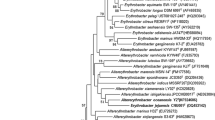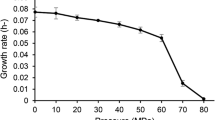Abstract
A new group of anaerobic thermophilic bacteria was isolated from enrichment cultures obtained from deep sea sediments of Peru Margin collected during Leg 201 of the Ocean Drilling Program. A total of ten isolates were obtained from cores of 1–2 m below seafloor (mbsf) incubated at 60°C: three isolates came from the sediment 426 m below sea level with a surface temperature of 9°C (Site 1227), one from 252 m below sea level with a temperature of 12°C (Site 1228), and six isolates under sulfate-reducing condition from the lower slope of the Peru Trench (Site 1230). Strain JW/IW-1228P from the Site 1228 and strain JW/YJL-1230-7/2 from the Site 1230 were chosen as representatives of the two identified clades. Based on the 16S rDNA sequence analysis, these isolates represent a novel group with Thermovenabulum and Caldanaerobacter as their closest relatives. The temperature range for growth was 52–76°C with an optimum at around 68°C for JW/IW-1228P and 43–76°C with an optimum at around 64°C for JW/YJL-1230-7/2. The pH25C range for growth was from 6.3 to 9.3 with an optimum at 7.5 for JW/IW-1228P and from 5 to 9.5 with an optimum at 7.9–8.4 for JW/YJL-1230-7/2. The salinity range for growth was from 0% to 6% (w/v) for JW/IW-1228P and from 0% to 4.5% (w/v) for JW/YJL-1230-7/2. The G+C content of the DNA was 50 mol% for both JW/IW-1228P and JW/YJL-1230-7/2. DNA–DNA hybridization yielded 52% similarity between the two strains. According to 16S rRNA gene sequence analysis, the isolates are located within the family, Thermoanaerobacteriaceae. Based on their morphological and physiological properties and phylogenetic analysis, it is proposed that strain JW/IW-1228PT is placed into a novel taxa, Thermosediminibacter oceani, gen. nov., sp. nov. (DSM 16646T=ATCC BAA-1034T), and JW/YJL-1230-7/2T into Thermosediminibacter litoriperuensis sp. nov. (DSM 16647T =ATCC BAA-1035T).


Similar content being viewed by others
References
Cashion P, Hodler-Franklin MA, McCully J, Franklin M (1977) A rapid method for base ratio determination of bacterial DNA. Anal Biochem 81:461–466
Cord-Ruwisch R (1985) A quick method for the determination of dissolved and precipitated sulfides in cultures of sulfide-reducing bacteria. J Microbiol Methods 4:33–36
Cragg BA, Parkes RJ, Fry JC, Herbert RA, Wimpenny JWT, Getliff JM (1990) Bacterial biomass and activity profiles within deep sediment layers. Proc Ocean Drilling Program Scientific Results 112:607–619
Cragg BA, Parkes RJ, Fry JC, Weightman AJ, Rochelle PA, Maxwell JR (1996) Bacterial populations and processes in sediments containing gas hydrates (ODP Leg 146:Cascadia Margin). Earth Planetary Sci Lett 139:497–507
Dailey HA Jr, Lascelles J (1977) Reduction of iron and synthesis of protoheme by Spirillum itersonii and other organisms. J Bacteriol 129:815–820
De Ley J, Cattoir H, Reynaerts A (1970) The quantitative measurement of DNA hybridization from renaturation rates. Eur J Biochem 12:133–142
D’Hondt S, Rutherford S, Spivack, AJ (2002) Metabolic activity of subsurface life in deep-sea sediments. Science 295:2067–2070
D’Hondt SL, Jørgensen BB, Miller DJ et al (2003) Proc ODP Init Repts 201 http://www-odp.tamu.edu/publications/201_IR/201ir.htm. http://www-odp.tamu.edu/publications/201_IR/chap_01/chap_01.htm
Dickens G (2001) On the fate of past gas: what happens to methane released from a bacterially mediated gas hydrate capacitor? Geochem Geophys Geosyst 2:2000GC000131
Felsenstein J (2001) PHYLIP (Phylogeny Inference Package) version 3.6a2.1. Department of Genome Sciences, University of Washington, Seattle
Finegold SM, Baron EJ (1986) Conventional and rapid microbiological methods for identification of bacteria and fungi. In: Finegold SM, Baron EJ (eds) Bailey and Scott’s diagnostic microbiology. The CV Mosby Co, St. Louis, pp 117–118
Freier D, Mothershed CP, Wiegel J (1988) Characterization of Clostridium thermocellum JW20. Appl Environ Microbiol 54:204–211
Guckert JB, Antworth CB et al (1985) Phospholipid ester-linked fatty acid profiles as reproducible assays for changes in prokaryotic community structure of estuarine sediments. FEMS Microbiol Ecol 31:147–158
House CH, Cragg BA, Teske A, The Leg 201 Scientific Party (2003) Drilling contamination tests during ODP Leg 201 using chemical and particulate tracers. In: D’Hondt SL, Jørgensen BB, Miller DJ et al. Proc ODP Init Repts 201:1–19 http://www-odp.tamu.edu/publications/201_IR/chap_05/chap_05.htm
Huss VAR, Festl H, Schleifer KH (1983) Studies on the spectrometric determination of DNA hybridization from renaturation rate. Syst Appl Microbiol 4:184–192
Jukes TH, Cantor CR (1969) Evolution of protein molecules. In: Munro HN (ed) Mammalian protein metabolism, Academic, New York, pp 21–132
Lane DJ (1991) 16S/23S rRNA sequencing. In: Stackebrandt E, Goodfellow M (eds) Nucleic acid techniques in bacterial systematics. Wiley, Chichester, pp 115–175
Ljungdahl LG, Wiegel J (1986) Anaerobic fermentations. In: Demain AL, Solomon NA (eds) Manual of industrial microbiology and biotechnology. American Society for Microbiology, Washington DC, pp 84–96
Mesbah M, Premachandran U, Whitman WB (1989) Precise measurement of the G+C content of deoxyribonucleic acid by high-performance liquid chromatography. Int J Syst Bacteriol 39:159–167
Parkes RJ, Cragg BA, Bale SJ, Getliff JM, Goodman K, Rochelle PA, Fry JC, Weightman AJ, Harvey SM (1994) Deep bacterial biosphere in Pacific-ocean sediments. Nature 371:410–413
Parkes RJ, Cragg BA, Wellsbury P (2000) Recent studies on bacterial populations and processes in subseafloor sediments: a review. Hydrogeol J 8:11–28
Saitou N, Nei M (1987) The neighbor-joining method: a new method for reconstructing phylogenetic trees. Mol Biol Evol 4:406–425
Shipboard Scientific Party (2003a) Explanatory notes. In: D’Hondt SL, Jørgensen BB, Miller DJ et al. Proc ODP Init Repts 201 http://www-odp.tamu.edu/publications/201_IR/chap_01/chap_01.htm.
Shipboard Scientific Party (2003b) Site 1227. In: D’Hondt SL, Jørgensen BB, Miller DJ et al. Proc ODP Init Repts 201 http://www-odp.tamu.edu/publications/201_IR/chap_08/chap_08.htm
Shipboard Scientific Party (2003c) Site 1228. In: D’Hondt SL, Jørgensen BB, Miller DJ et al. Proc ODP Init Repts 201 www-odp.tamu.edu/publications/201_IR/chap_09/chap_09.htm
Shipboard Scientific Party (2003d) Site 1229. In: D’Hondt SL, Jørgensen BB, Miller DJ et al. Proc ODP Init Repts 201 www-odp.tamu.edu/publications/201_IR/chap_10/chap_10.htm
Shipboard Scientific Party (2003e) Site 1230. In: D’Hondt SL, Jørgensen BB, Miller DJ, et al. Proc ODP Init Repts 201 www-odp.tamu.edu/publications/201_IR/chap_11/chap_11.htm
Thompson JD, Gibson TJ, Plewniak F, Jeanmougin F, Higgins DG (1997) The CLUSTAL_X windows interface: flexible strategies for multiple sequence alignment aided by quality analysis tools. Nucleic Acids Res 25:4876–4882
Wayne LG, Brenner DJ, Colwell RR et al (1987) International Committee on Systematic Bacteriology. Report of the ad hoc committee on reconciliation of approaches to bacterial systematics. Int J Syst Bacteriol 37:463–464
White DC, Davis WM et al (1979) Determination of the sedimentary microbial biomass by extractable lipid phosphate. Oecologia 40:51–62
Whitman WB, Coleman DC, Wiebe WJ (1998) Prokaryote: the unseen majority. Proc Natl Acad Sci USA 95:6578–6583
Widdel F, Bak F (1992) Gram-negative mesophilic sulfate-reducing bacteria. In: Baloes A, Trüper HG, Dworkin M, Harder W, Schleifer K-H (eds) The procaryotes. Springer, Berlin Heidelberg New York, pp 583–624
Wiegel J (1981) Distinction between the Gram reaction and the Gram type of bacteria. Int J Syst Bacteriol 31:88
Wiegel J (1998) Anaerobic alkalithermophiles, a novel group of extremophiles. Extremophiles 2:257–267
Wise MG, McArthur JV, Shimkets LJ (1999) Methanotroph diversity in landfill soil: isolation of novel type I and type II methanotrophs whose presence was suggested by culture-independent 16S ribosomal DNA analysis. Appl Environ Microbiol 65:4887–4897
Xue Y, Xu Y, Liu Y, Ma Y, Zhou P (2001) Thermoanaerobacter tengcongensis sp nov, a novel anaerobic, saccharolytic, thermophilic bacterium isolated from a hot spring in Tengcong, China. Int J Syst Evol Microbiol 51:1335–1341
Zavarzina DG, Tourova TP, Kuznetsov BB, Bonch-Osmolovskaya EA, Slobodkin AI (2002) Thermovenabulum ferriorganovorum gen nov, sp nov, a novel thermophilic anaerobic, endospore-forming bacterium. Int J Syst Evol Microbiol 52:1737–1743
Zelles L (1997) Phospholipid fatty acid profiles in selected members of soil microbial communities. Chemosphere 35:275–294
Acknowledgements
This study was supported by a shipboard grant for Ocean Drilling Program (ODP) Leg 201 and post-cruise grant (USSSP-Grant# 201-F002587 and 201-F001649) to J.W. ODP is sponsored by the U.S. National Science Foundation (NSF) and participating countries under management of Joint Oceanographic Institutions (JOI), Inc. We would like to thank all members of the shipboard party for their great hospitality and help in collecting samples. We also thank J.P. Euzeby for his help regarding the Latin nomenclature, M.A. Eiteman for his fermentation end products analysis, and W.B. Whitman for his help with the G+C mol% determination. Y.L. was supported by a graduate fellowship from the Savannah River Ecology Laboratory, which is funded by the Environmental Remediation Sciences Division of the Office of Biological and Environmental Research, U.S. Department of Energy, through Financial Assistance Award No. DE-FC09-96-SR18546 to the University of Georgia Research Foundation. I.D.W. was supported by the NSF-REU site program (NSF-0139083).
Author information
Authors and Affiliations
Corresponding author
Additional information
Communicated by K. Horikoshi
An erratum to this article can be found at http://dx.doi.org/10.1007/s00792-006-0521-4
Rights and permissions
About this article
Cite this article
Lee, YJ., Wagner, I.D., Brice, M.E. et al. Thermosediminibacter oceani gen. nov., sp. nov. and Thermosediminibacter litoriperuensis sp. nov., new anaerobic thermophilic bacteria isolated from Peru Margin. Extremophiles 9, 375–383 (2005). https://doi.org/10.1007/s00792-005-0453-4
Received:
Accepted:
Published:
Issue Date:
DOI: https://doi.org/10.1007/s00792-005-0453-4




